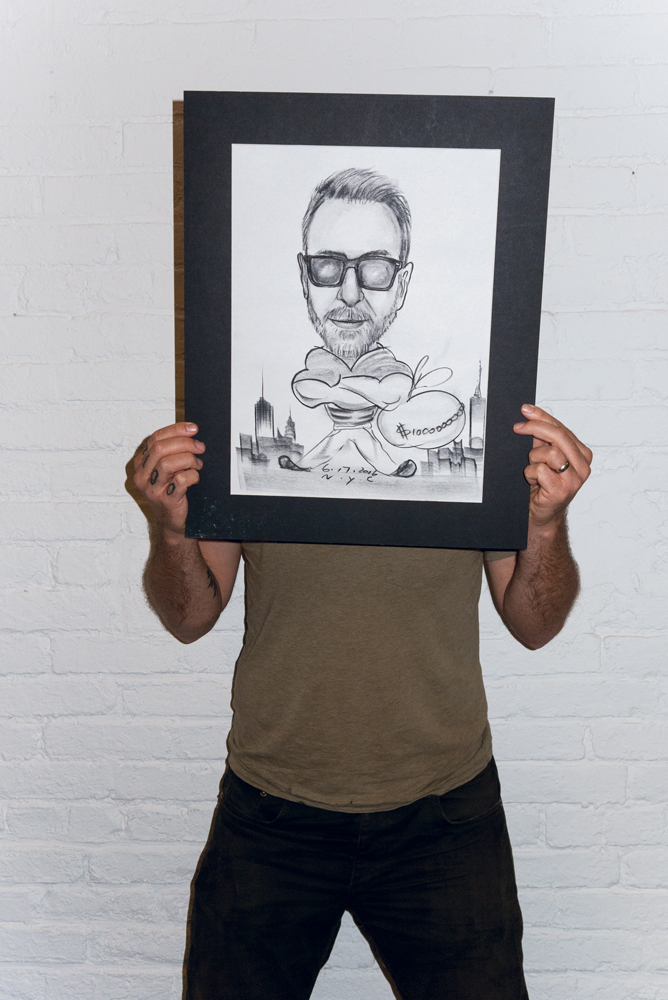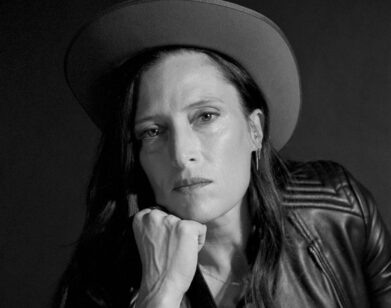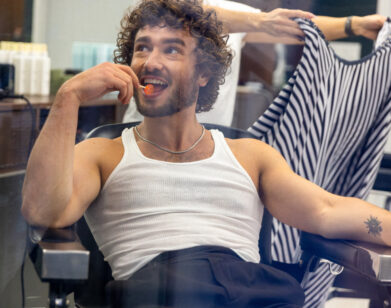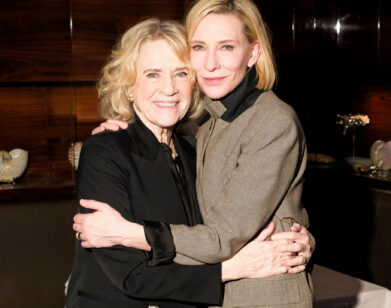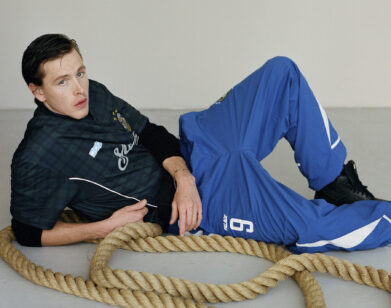Derek Cianfrance
Derek Cianfrance is quite the romantic. And like all romantics, he seems quick to have his heart broken by our failures to live up to romantic ideals. Evidence of our flaws, our pettiness, can, for the romantic, bring the sky down-or make for a great movie. The filmmaker’s huge breakout, 2010’s Blue Valentine, is just such a movie, starring Ryan Gosling and Michelle Williams as an embattled couple on top of whom the sky is falling. It is also at least in part about Cianfrance the romantic, the son, and the filmmaker coming into his own.
Growing up in Colorado, Cianfrance, 42, loved movies, loved images. As he tells one of his heroes, Gena Rowlands, he was mesmerized by the dissonance between the sunny images he saw in his home and the more turbulent reality they belied. As an undergraduate at the University of Colorado Boulder, he studied with two legends of avant-garde cinema—Stan Brakhage and Phil Solomon. After school, Cianfrance found work on documentaries. And his later facility for portraying gritty realism, in Blue Valentine, and 2013’s The Place Beyond the Pines, was electric. But in his latest film, the rapturous and subtly Hitchcockian The Light Between Oceans, starring Michael Fassbender, Alicia Vikander, and Rachel Weisz, and set in a near mythical landscape at the end of the world, Cianfrance has utterly given over to his inner romantic. The result is quite sensational.
GENA ROWLANDS: Hi! Mr. Ci-an-france, right?
DEREK CIANFRANCE: That’s right. And it’s Genn-a, not Gee-na?
ROWLANDS: Yes. [laughs] All right, we’ve got the main questions settled. I can’t tell you how much I loved The Light Between Oceans. I don’t like to be too effusive, but “brilliant” is the only thing that covers it. I was crying like an idiot as I left. It was so beautifully acted. I loved Alicia [Vikander] and Rachel [Weisz]. It’s just one of the best pictures I’ve ever seen in my life.
CIANFRANCE: Oh my gosh. Well, that’s the greatest compliment I’ve ever heard because I would never be making movies if it weren’t for you. In film school, my professor Stan Brakhage showed us Faces [1968]. I was 19 years old. And, I have to say, for the first 20 minutes or so, I was so lost within the movie. I couldn’t really understand it. But as it kept going, I was … It absolutely changed my life because it was actually alive. The film itself was alive. And the catharsis that I found at the end of that movie completely changed my vision of what a film could be. In some ways, the films you’ve made have been some of my closest friends-they’re always there for me like a friend of mine. The remarkable thing about your films is that they actually change over time. When I watched A Woman Under the Influence [1974] for the very first time, I thought it was a movie about a crazy woman. And when I watched it a couple years ago, before I started shooting Light Between Oceans, I realized that she was the only sane person in that movie. And that the world around her was crazy. And to have such a change of perspective is a testament to the strength and the purity and the life that you guys captured in those movies and in your performances. I’ll stop by saying, as I was casting the roles for Light Between Oceans, the first thing I told my casting director was that I needed Gena Rowlands from A Woman Under the Influence.
ROWLANDS: Ah, well, John [Cassavetes] is the one that deserves those compliments. He created it. He could write wonderful screenplays and then let you have the freedom to play them as well as you could.
CIANFRANCE: I was wondering, in those films, how free were you to embarrass yourself, make mistakes?
ROWLANDS: I just play them as I see them. And it works or it doesn’t work, and that’s all you can do. You know what touched me about your viewing of A Woman Under the Influence, how it changed for you, I was looking at it the other day, and the thing that really had not occurred to me before, after all these years, was the fact that men are so seldom given anything but very tough parts in movies, and Peter [Falk] was so extraordinarily gentle and understanding of this woman that obviously had problems. But he loved her. That was just a thing that I hadn’t seen. Peter was a wonderful actor. He was always good, but there’s something about him in that that was extraordinary.
CIANFRANCE: That’s the thing about the films that you all made together: They’re just purely courageous. And the courage that you and Peter and Ben [Gazzara, another frequent Cassavetes collaborator] and John and everyone showed in John’s films has always been my North Star.
ROWLANDS: You sure accomplished it with this one. I mean, you just pulled so hard for every single person in the picture.
CIANFRANCE: I give credit to the author of the book this was adapted from. She was a lawyer. M.L. Stedman. I read the book about a month after I had been on jury duty. I guess I haven’t always cared too much about lawyers. The thing that happened to me on jury duty was, when the prosecution was speaking, I was certain that the defendant was guilty-until the defense was speaking, and then I was certain that he was innocent. And I realized, from reading her story, that a lawyer actually has to see all sides of a situation. Lawyers actually might be the most understanding human beings.
ROWLANDS: You started making films at age 13?
CIANFRANCE: Yeah. I was a member of the VHS generation. I used to study movies as a kid because I had a VCR and could record a movie on HBO and just watch it repeatedly. The first movie we rented was Creepshow [1982] directed by George Romero. I remember watching it at my brother’s slumber party. A few months later we bought a VCR, and Creepshow came on HBO, and we recorded it, and I watched it every day. I had a huge library of movies that I would study. I couldn’t get enough of watching movies growing up.
ROWLANDS: And did you get your friends to make movies with you?
CIANFRANCE: Friends and family.
ROWLANDS: Us, too, in our pictures. There’s so many of our family and good friends in different parts, big and little. That used to amuse me a lot. I wondered if everybody else did that, or if they would admit it.
CIANFRANCE: I mean, that was one of the things about Faces that affected me so much. It felt so deeply intimate and personal. When I was a kid, I was making ridiculous, adolescent movies about possessed bats or whatever it was. But I was using my grandma as the lead actor, so I felt a real connection to that. We had all these smiley family pictures all over the walls of my house, but I always found those pictures to be odd because we weren’t smiling all the time. I don’t want to paint the picture of a total dysfunctional house, but there were a lot of arguments in that house. A lot of pain. And yet we had these smiling family pictures. And so did all my friends’ families. I remember being in my friend’s basement playing pinball and hearing his father and mother drunk, beating each other up. So before I picked up a video camera, I was taking stills. As a kid I refused to smile for pictures because I felt like it wasn’t real, and as a photographer I was going to try to take a picture of something real. So I used to take pictures of fights in my house.
ROWLANDS: Well, that must have made you popular.
CIANFRANCE: [laughs] They didn’t like it. I have one of my dad cursing me out in the middle of the desert when he blew a tire.
ROWLANDS: How did your grandmother cooperate?
CIANFRANCE: She was game for it. I had a tape recorder, and I used to hide it and interview her.
ROWLANDS: That was pretty sneaky of you, wasn’t it?
CIANFRANCE: It was very sneaky. You know, it happens sometimes that when someone has a camera, they change; sometimes they change for the better. My thing with the family pictures was that everyone seemed to, in front of the camera, get perfect. And when the camera went down, everyone became real again. So that was my thing, to make real portraits of the people and the emotions inside my home.
ROWLANDS: Are you working on something now?
CIANFRANCE: I’m writing a script called Empire of the Summer Moon. It’s a western about the end of the Comanche empire.
ROWLANDS: Where will you shoot it?
CIANFRANCE: Oklahoma and Texas. I don’t think we’ve really seen a real portrait of that era. You know, we’ve seen the John Wayne westerns-and the Kevin Costner westerns which were all kind of about white liberal guilt.
ROWLANDS: I agree with you. There is an audience that would like to see what it was really like.
CIANFRANCE: That’s my next quest, I guess-to make a true portrait of this American landscape. I don’t know if it’s too oblique or too subtle, but did you notice I put an homage to one of your films in Light Between Oceans?
ROWLANDS: No. What was it?
CIANFRANCE: You know when Alicia shaves Michael’s mustache? Michael had the idea to have a mustache and have it shaved. And one of my favorite moments is when you shave Seymour Cassel’s mustache in Minnie and Moskowitz [1971]. So I put that in there as an homage to you.
ROWLANDS: I’ll tell Seymour if I ever see him. I haven’t seen him in a long time.
CIANFRANCE: I can’t tell you, Gena, when we were about to shoot Alicia shaving Michael’s mustache, the machine of filmmaking got so nervous. The art department and the props department got so nervous that she was going to cut him. And I said, “Well, let me ask her.” I said, “Alicia, do you feel like you can do this?” She said, “I think so.” I said, “Do you think you’re going to cut him?” She said, “I’ll try not to.” And then I asked Michael, “Michael, how do you feel about it? Are you comfortable with her shaving you?” And he said, “Yeah, I’m comfortable with it.”
ROWLANDS: “No, I think she’s going to cut me!” [laughs] Then what would you have done? You have to hypnotize one of them.
CIANFRANCE: [laughs] As an actor, were you convinced to do things you didn’t want to do?
ROWLANDS: Well, John was an extremely free director. He wrote it. It was there. And you did what you wanted to with it. That was his attitude. And if it wasn’t what he had wanted, we didn’t know about it. He really gave the actors a great deal of latitude interpreting his work. Of course, he knew what he was doing. And I’m not sure we always did it as well as he would’ve liked, but he never pushed you one way or the other.
CIANFRANCE: I tell the actors that the biggest gift they can give me is to fail. And that the second gift they can give me is to surprise me.
ROWLANDS: Well, I think you’ve got it wrapped up then!
CIANFRANCE: There’s one rule that I have on my movies, which is that anything that you want to do, you can do. But! There’s a flip side to that, which is that anything I want you to do, give it a try also.
ROWLANDS: “You better do it.” [laughs] The only thing John ever told everybody that was a really hard rule was that you never stop because you made a mistake or did something you thought you hadn’t done well-you did not ever stop. And that was strange, because you do have the temptation once in a while to think you could have done something better. I think that perhaps is the best way, because the editor has the right to stop it.
CIANFRANCE: Let it be alive. I learned from years and years of doing documentaries- that was the work I could get, so I was making documentaries, and I fell in love with that kind of speed of life, the speed of things not stopping, no second takes. There’s something so glorious in giving control to the world. I think that’s what I’m trying to do in my films-control the world but also let it be chaotic, let there be life. But if you shoot digital … When I was shooting Blue Valentine with Ryan Gosling and Michelle Williams, there was a 48 minute take of them eating dinner together in a hotel suite. We didn’t stop, and it got so boring that Ryan actually fell asleep at the table.
ROWLANDS: [laughs] Now that’s relaxed! He is a very good actor.
CIANFRANCE: Yeah, he’s incredible. To be able to fall asleep in the middle of the scene. [laughs] You know, I made that film because when I was 20 and moved out of the house, my parents divorced and I was trying to have a healthy relationship of my own. And so Blue Valentine was written from that fearful place of being a young adult trying not to repeat the past pain. Everything in that movie I either witnessed or experienced, dreamed or caused. That was a very, very personal movie. You know, my mom and dad are so proud of me for making movies, but also they’re human beings, too, and it’s hard to put such personal pain up on there. To show it to the world.
ROWLANDS: Were they offended by it?
CIANFRANCE: They’ve always been incredibly proud. But I don’t know. Was that ever hard for you? There had to be some of your real life in those movies, wasn’t there?
ROWLANDS: Well, if there was, I didn’t notice. But, you’re right, you couldn’t escape having some of yourself in it. But I never thought of anything except my character. Nothing. It was all gone. I don’t know where it went, but I only thought of my character. So I don’t know how much of my own personal life affected things. That’s so interesting, the idea of a little kid always being haunted by these wonderful smiling pictures.
CIANFRANCE: I think the purpose of my movies is to help me figure that out.
ROWLANDS: After your parents divorced, did they start putting up other kinds of pictures?
CIANFRANCE: No. They’re still everywhere! Every house I go to. I’m at my mom’s house right now in Colorado. I took my family on a road trip this summer, and we’re all in Colorado visiting family, and I’m looking at some smiling pictures right now. [laughs] And I understand. I have two sons, Walker, who’s 12, and Cody, who’s 9, and Cody, I didn’t tell him my ideas about not smiling for pictures, but he does not smile for pictures. [Rowlands laughs] He’s a chip off the old block. And when he comes home, everyone in my family is saying, “Oh, come on, Cody, you can give us one smile!” But he won’t. I promise I did not train him to do that. He just does it.
ROWLANDS: It’s genetic. What was your greatest takeaway from studying with Brakhage and Solomon?
CIANFRANCE: Stan Brakhage and Phil Solomon, two great American film artists. I got to spend six years basically witnessing what the life of an artist was like from both of them. Brakhage was my film history professor, and, like showing me Faces, which changed my life, he would do things that gave me a different way to see. He showed Ivan the Terrible, Part II [1947] to our film history class. And he instructed the projectionist to rack the projector completely out of focus. So what we watched for an hour and a half was just this collision of shadow and light up on the screen. And what I realized was that for Eisenstein, in every edit, every shot was a collision with another shot. Brakhage allowed us to deconstruct film, really. The last time I saw Brakhage was at a used bookstore in Boulder, Colorado, in 1999. He bought me Ray Carney’s Cassavetes on Cassavetes book as a gift. I think he knew how much those movies affected me, and that’s why he got me the book. And then Phil Solomon … He’s one of my closest friends to this day. I can’t do anything in filmmaking without hearing his voice. He’s my cinematic consciousness, and he’s always there to challenge me, a great father figure to me in movie-making. And, like a father, he’s not a yes man. He’s my harshest critic and my best ally for being that way.
ROWLANDS: That’s a wonderful thing to have. Do you have any smiling pictures of him in your room?
CIANFRANCE: [laughs] No!
ROWLANDS: And he was in Colorado, too?
CIANFRANCE: Yeah. He’s one of my professors that I’ve kept in contact with all these years since. I’ll see him next week since I’m out here in Colorado. He’s one of our great American artists. I had such a fortunate and a different kind of film education because I was studying under these two avant-garde legends. It all felt like destiny.
GENA ROWLANDS IS A TWO-TIME ACADEMY AWARD-NOMINATED ACTRESS AND WAS THE RECIPIENT OF AN HONORARY ACADEMY AWARD IN 2015.

